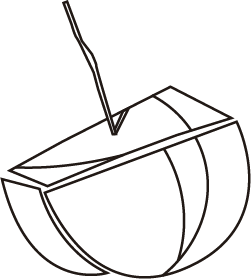The spring known as La Font del Llimener is the only important spring on the valley’s south-facing slope, La Solana. While it is true that there are other springs too, these nevertheless have a very irregular flow and are often sporadic springs, only flowing after heavy rains. It is recommended to visit La Solana in winter and early spring or in autumn, especially after the first and refreshing rains of late summer, due to the fact that the rays of sunlight are harsh from the middle of the morning until well into the afternoon, especially during the months when the days are longest. El Llimener is the name of an area located on the south-facing slope of La Vall de Gallinera, overlooking the village of Alpatró, watching over the Benissili ravine and over the entire Sierra Foradada, which embraces, in its innermost part, Llombos, Xarpolar and Benissili Castle.
The trail starts in Alpatró, in front of the Moltó mill (currently the Ethnological Museum of the local association Unió Cultural d’Amics i Amigues de la Vall de Gallinera) and, going down the ramps that lead to the path towards La Carroja next to the Gallinera River, it passes near the ancient threshing areas where the wheat was separated from the chaff.
Looking north from the village it is possible to see the Castellot, the pens and the cactuses with their prickly pears. The Castellot was a tower and refuge that had the function of accommodating the population of the Alpatró farmhouses in times of instability. Its chronology dates back to the 13th century. Remains from the Bronze Age and the Iberian period have also been found in this specific area (Torró, 1985).
The path zigzags down to the river, leaving behind on the right the old La Carroja path. The trail passes by a rocky place full of smooth greyish stones, with crevices brimming with pale stonecrop, mosses and small ferns such as rustyback (Ceterach officinarum). The trail reaches the riverbed and crosses it at the point where the Benissili and Llombai ravines meet. The path continues along the edge of this second ravine until it reaches an old quarry where there are some crosses carved into the stone and the remains of the extraction of some pieces intended for the construction of entrance gates. From there, the hike continues to the left, climbing upwards, giving the hiker a chance to enjoy the great diversity of herbs and shrubs that can be found along the path: stone breaker (Hypericum ericoides), rock tea (Jasonia glutinosa), Montpellier Coris (Coris monspeliensis), Corsican heath (Erica terminalis) and some stonecrops (Sedum sp). Bare stone areas alternate with the typical scrub of sunny places with winter heather (Erica multiflora), rosemary (Rosmarinus officinalis), mastic (Pistacia lentiscus), lily pink (Aphyllanthes monspeliensis), narrow-leaved mock privet (Phillyrea angustifolia), common thatching grass (Hyparrhenia hirta), Mediterranean dwarf palm (Chamaerops humilis) and many other plants.
To the right of the path there is a farm with immense terraces, with praiseworthy dry stone walls, and at the top of these terraces, the trail reaches the Llimener spring that flows from inside a hollow in the rocks.
If the hiker follows the path upwards, he or she arrives at a metal fence. To the left, the remains of the Molinet, to the right the path that leads towards the La Llacuna and L’Orxa track.
If anybody feels like taking a longer route, it is possible to return left of the track and go straight down to the village of Llombai, following the path, or it is also possible to turn right in order to go down a path which leads to Benissili, the Rellamp slope.






